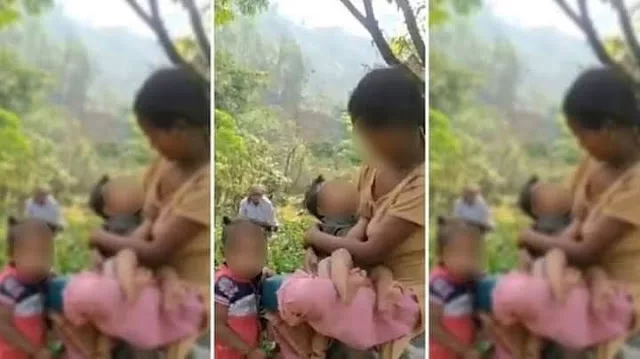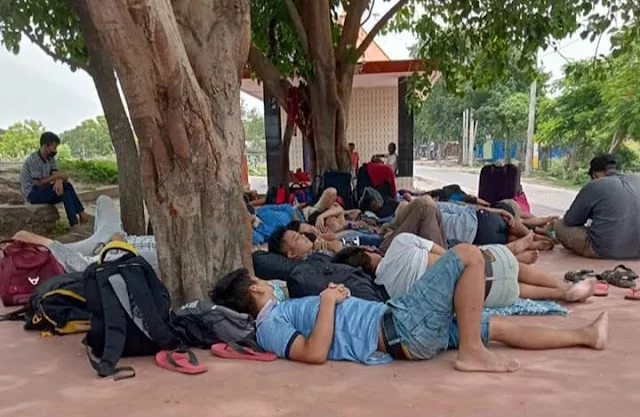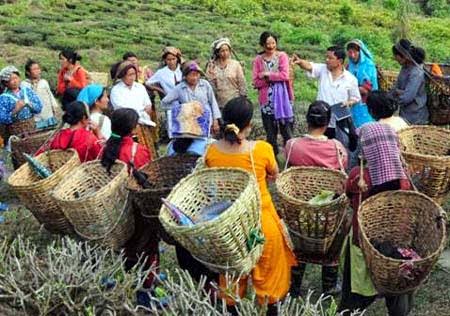 |
| Kirat or Kirati history and Culture |
Although only the Sunuwar(the people who inhabit the region westward of River Sun Koshi),Khumbu or Khambu (also known as Rai),Limbu (also known as Yakthumba or Subba) and Yakha (also known as Dewan or Zimdar) are generally called Kirati, the vast majority of ethnic people of the region eastward of Nepal too call themselves as Kirati. These people are also best known as modern Gurkhas. Their languages belong to the Tibeto-Burman family of languages.
The original inhabitants of the Dooars region of India, i.e., the Koch and Mech, also claim themselves to be Kiratis and so do the Bodo and Kachari tribes of Assam.. They derive their titles from the original place of their dwelling, i.e., Koch from the Kosi River, Mech from the Mechi River and the word Kachari is derived from Kachar which means river basin. The basis of these claims relies on the fact that they areMongoloids even though they distinguish themselves from Mongolians elsewhere. They are therefore often identified as Kirati-Mongolians.
 |
| Kirat King Yalamber, who defeated the last Yadava king, Bhuvan Singh |
ETYMOLOGY
The source of the word Kirat or Kirati is much disputed. One school of thought says that it comes from the Sanskrit word Kirata found in the Yajur Veda, describing the handsome mountain people and hunters in the forests. It is also described as Chinese in the Mahabharat, Kirtarjuniya.
RELIGION
KIRAT PEOPLE PRACTICE SHAMANISM BUT THEY CALL IT “KIRAT RELIGION”. THE KIRATIS FOLLOW KIRAT MUNDHUM. THEIR HOLY TEXT IS THE MUDHUM, ALSO KNOWN AS THE KIRAT VEDA. KIRAT RAI WORSHIP NATURE AND THEIR ANCESTORS. ANIMISM AND SHAMANISM AND BELIEF IN THEIR PRIMEVAL ANCESTORS, SUMNIMA AND PARUHANG ARE THEIR CULTURAL AND RELIGIOUS PRACTICES. THE NAMES OF SOME OF THEIR FESTIVALS ARE SAKELA, SAKLE, TASHI, SAKEWA, SALELADI BHUNMIDEV, CHYABRUNG, YOKWA AND FOLSYANDAR. THEY HAVE TWO MAIN FESTIVALS: SAKELA/SAKEWA UBHAULI DURING PLANTATION SEASON AND SAKELA/SAKEWA UDHAULI DURING THE TIME OF HARVEST.
Kirat Limbu people believe in a supreme god called Tagera Ningwaphuma, who is also known as the supreme knowledge. The Kirat ancestor Yuma Sammang and god of war Theba Sammang are the second most important deities.
Kirats in Nepal were forced into taking Hindu names and accept Hinduism during the Prithvi Narayan Shah’s Khasnization Policy and the later Khas rulers of Nepal maintained this policy. Many of the Kirat initially stayed away from Hinduism but were encouraged to convert by the ruling elites of later Nepal.
There is a giant linga of the Kirat at Kirateshwara. It believed that all Kirat names, language and traditions were suppressed by the Khas rulers and people, but all such evidences were destroyed by the next rulers of Nepal.
HISTORY
The Kiratas mentioned in early Hindu texts are tribes of the forest and mountains. They are often mentioned along with the Cinas (Chinese). In Yoga Vasistha 1.15.5, Rama speaks of “kirAteneva vAgurA”, “a trap [laid] by Kiratas”, so about BCE Xth century, they were thought of as jungle trappers, the ones who dug pits to capture roving deer. The same text also speaks of King Suraghu, the head of the Kiratas who is a friend of the Persian King, Parigha. Hindu myth also has many incidents where the god Shiva imitates a Kirat person.
Contemporary historians widely agree that a widespread cultural exchange and intermarriage took place in the eastern Himalayan region between the indigenous inhabitants – called the Kirat – and the Tibetan migrant population, reaching a climax during the 8th and 9th centuries. Another wave of political and cultural conflict between Khas and Kirat ideals surfaced in the Kirat region of present-day Nepal during the last quarter of the 18th century. A collection of manuscripts from the 18th and 19th centuries, till now unpublished and unstudied by historians, have made possible a new understanding of this conflict. These historical sources are among those collected by Brain Houghton Hodgson – a British diplomat and self-trained orientalist appointed to the Kathmandu court during the second quarter of the 19th century – and his principal research aide, the Newar scholar Khardar jitmohan.
For over two millennia, a large portion of the eastern Himalaya has been identified as the home of the Kirat people, of which the majority are known today as Rai, Limbu and Yakkha. In ancient times, the entire Himalayan region was known as the Kimpurusha Desha (also, Kirata
Pradesh), a phrase derived from a Sanskrit term used to identify people of Kirat origin. These people were also known as Nep, to which the name Nepala is believed to have an etymological link. The earliest references to the Kirat as principal inhabitants of the Himalayan region are found in the texts of Atharvashirsha and Mahabharata, believed to date to before the 9th century BC. For over a millennium, the Kirat had also inhabited the Kathmandu Valley, where they installed their own ruling dynasty. This Kirat population in the valley along with original Australoids and Austro-Asiatic speakers form the base for later Newar population. As time passed, however, those Kirat, now known as the Limbu, settled mostly in the Koshi region of present-day eastern Nepal and Sikkim.
 |
| Kirati traditional dress |
From around the 8th century, areas on the northern frontier of the Kirat region began to fall under the domination of migrant people of Tibetan origin. This flux of migration brought about the domination by Tibetan religious and cultural practices over ancient Kirat traditions. This influence first introduced shamanistic Bon practices, which in turn were later replaced by the oldest form of Tibetan Buddism. The early influx of Bön culture to the peripheral Himalayan regions occurred only after the advent of Nyingma, the oldest Buddhist order in Lhasa and Central Tibet, which led followers of the older religion to flee to the Kirat areas for survival. The Tibetan cultural influx ultimately laid the foundation for a Tibetan politico-religious order in the Kirat regions, and this led to the emergence of two major Tibetan Buddhist dynasties, one in Sikkim and another in Bhutan. The early political order of the Kingdom of Bhutan had been established under the political and spiritual leadership of the lama Zhabs-drung Ngawang Namgyal. Consequently, Bhutan used to be known in the Himalayan region as the ‘kingdom of [Buddhist] spiritual rule’ (in old Nepali, dharmaako desh). The Tibetan rulers of Sikkim were also known as Chogyal, or spiritual rulers.
Both of these kingdoms adopted policies of suppression of indigenous practices, replacing them with those of Tibetan Buddhism. Bhutan’s religious rulers established a tradition of appointing religious missions to other Himalayan kingdoms and areas, through which they were able to establish extensive influence in the region. Bhutan’s ambitious missions were sent as far west as Ladakh. Even before the founding of modern Nepal by Prithvi Narayan Shah of Gorkha in 1769, Bhutan’s rulers were able to establish spiritual centres in several parts of what was to become the former’s territories, including Kathmandu, Bhaktapur,Gorkha and Vijayapur in the midhills, and Mustang, north of the central Himalayan range.
The Kirat were the earliest inhabitants of the Kathmandu Valley. Dhimal,Hsyu, Koch, Thami Tharu Chepang and Surel ethnic groups also consider themselves to be of Kirati descent. According to recent DNA and HLA typing done on the Kirat people of Nepal, Bhutan and India, these people’s ancestors migrated from south-east Tibet near the Burma border. However, Kirat people are not Khampa. Recent DNA studies on Tibeto-Burmese peoples have shown them to have both Southeast Asian and Northeast Asian origins. According to Kirati folklore, their ancestors migrated in a great volkerwanderungen from their ancestral homeland eastward to South-East Asia and beyond when Buddhist monks returned with glowing tales of availability of vast fertile lands.
That the monks-emissaries traveled to South-Eastern Asia spreading the doctrine of Four Noble Truths is evident from the fact that traces of pre-Brahminic culture is strongly visible in these lands. For example, the Hindu worshippers on Bali practice a mainly pre-Brahminic form of Hinduism, which early Chinese pilgrims categorized as Deota-Worshipping (deva-worshipping in Brahminic spelling). This peculiar form of Deota-Worshipping, mixed with an archaic form of Buddhism, in Balinese culture has roots deep inside the Kirati culture of pre-Brahminic Nepal.
The Sage of the Sakyas, soon after his Enlightenment had visited the Kiratdom of Kathmandu and worshipped at the Temple of Swayambhunath, the Adi Buddha, the Primordial Buddha during the reign of Kirati King Jite Dasti. Tradition has it that King Jite Dasti and his subjects were converted to the path of Nirwan (Brahminic spelling Nirvana) during this visit. However, King Jite Dasti decreed that his subjects were free to continue to worship Paru Hang (brahmnic name Shankar) while following the Four Noble Truths and this is the provenance visible in Nepal as well as Bali.
Furthermore, the Balinese worship Pancha-Dhyani aspects of the Buddha of Nepalese culture e.g., Akshobhya, Amitabha, Amoghasiddha, Bhairochana and Ratnasambhawa referring to them as various Deotas of the Brahminic pantheon. These divinities are totally unknown in Hindu India. The Balinese also worship the Nepalese deity Manjusri, the Celestial Architect, which is also unknown to the Hindus of Brahminic culture. None but the Kirati-Mongolians of pre-Brahminic Nepal could have transplanted their culture to Bali, a culture which had remained virtually unknown to the world outside until its presence was discovered by a Dutch scholar in 1814.
Te-ongsi Sirijunga Xin Thebe and Kirat revival:
Te-ongsi Sirijunga Xin Thebe or Teyongshi Ziri Dzö-nga Xin Thebe was an 18th-century Limbu scholar, teacher, educationist, historian and philosopher of Limbuwan and Sikkim. He was formally known as Sirichongba but his more popular name was and remains Sirijanga. Sirijanga researched and taught the Kirat-Sirijonga script, language and religion of the Limbus in various part of Limbuwan and Sikkim. He revived the old Kirat script.
History of Limbuwan: Kirat people of Limbu nationality
Limbuwan had a distinct history and political establishment until its unification with the kingdom of Gorkha in 1774 AD. During King Prithvi Narayan Shah’s unification of Nepal, the present-day Nepal east of Arun and Koshi rivers was known as Pallo Kirat Limbuwan. It was divided into 10 Limbu kingdoms of which Morang kingdom was the most powerful and had a central government. The capital of Morang kingdom was Bijaypur (present-day Dharan). After the Limbuwan Gorkha War and seeing the threat of the rising power of the British East India Company, the kings and ministers of all the 10 Limbu kingdoms of Limbuwan gathered in Bijaypur to agree upon the Limbuwan-Gorkha Treaty. This treaty formally merged the 10 Limbu kingdoms into the Gorkha kingdom but it also had a provision for autonomy of Limbuwan under the “kipat” system.
Gorkhali hegemonies
The next phase of military and cultural threat faced by the Kirat people was at the hands of the Gorkhali expansionists of Nepal, shortly after Sirijanga’s death. The nature and intensity of this hegemony was to prove significantly different from that of the earlier Tibetan one, however. From the very beginning, the Gorkha court’s intention in the region was not the extension of its Hindu-based culture. Rather, Gorkha’s was a clear military campaign of territorial expansion.
After the completion of the conquest of the Kathmandu Valley in 1769, the Gorkhali army marched east towards the Kirat territory. The Sen rulers of eastern Nepal, known as Hindupati, had established a weak rule in the Kirat region by adopting a policy of mutual understanding with the local Kirat leaders. The Gorkhali military campaign, in contrast, brought with it a forceful and brutal occupation. During the conquest, the invading authorities adopted a harsh divide-and-rule policy: they first asked the Kiratis to surrender, assuring them that they would retain local rule and their traditional order. After many took up this offer, however, the conquerors instead demanded that Gorkhali rule be obeyed and Gorkhali traditions be followed. Manuscripts in Hodgson’s collection make mention of Kirat men, male children and pregnant women having been murdered in great numbers.
The Gorkhalis ultimately divided the Kiratis into two groups, the sampriti and the niti: the former were those who had surrendered to Gorkhali power and cultural traditions, while the latter maintained their own traditions. The Gorkhali authorities naturally favoured the sampritis, killing the nitis or forcing them to flee their lands. As a result, much of the niti population migrated towards Sikkim and Bhutan. But Gorkhali wartime policy changed, particularly after the conquest of the territories of Kumaun and Garhwal far in the west. By the end of the 18th century, the authorities in Kathmandu were in need of more state revenue, and implemented a policy to bring people into Nepali territory in order to make barren land arable. The Kirat who were ousted from their lands during the Gorkhali military conquest were also asked to return home, albeit under the condition that Gorkhali rule and traditions were strictly followed. Relatives and friends of those who had fled were recruited to call them back, and people moved again between the state-given identities of niti and sampriti.
The History of Sunuwar
This ethnic group belongs to the deity of Pandava lineage as Raja Kooli duma mooli. They do not belong to Kirati grouped but inadvertently grouped by the Indian Scholar compiler of Veda called Ved Vyas as indiginious Kirati. They are the direct descendants of great pandava prince Bhimsena by Ghatotkacha’s son Bar Barey. Though Bar Barey was never married in his life time his head was miraculously severed by Sudarshan Chakra and was kept in meditation with the resurrection by the power of Cosmic divine light which helped him see the cosmic drama and witnessed about who actually fought Mahabharata war. He was kept as cosmic invissible witness to see the great war of Truth and evil. He explained his Pandava grandfathers the details about who won the great war. He confirmed that it was the Sudarshan Chakra who actually fought single handedly all the entire war. It killed Bhisma Pitamah, Karna, Dronacharya but spared the life of majority of Kiratis at the will of Lord Krishna. Lord Krishna has never fought the war and never killed any sentient beings. After almost all the scenes of Mahabharata, Lord Krishna showed the Cosmic Divine Transcendental to Bar Barey and declared thus ” My dear son, Bar Barey, I am pleased by your meditation and witness fot the truth over evils. Your progenies will be called Sunu varam(Sunuwar), who shall be come forth out of your eternal light of your Third eyes as the part and parcels of your soul in the form of golden dove and shall live forever. Your progenies were previously gopies and gwalas who will be reborn again as a brown complexioned as your speech incarnation. They shall go, multiply and be fruitful. Their look will symbolize like doves which is the sign of love and peace. You will never perish, you have now got an eternal life in the Supreme abode of mine the Spiritual world. They will worship my unpronounced primordial Word, and meditate upon it. This will be called Sruti Veda, i.e. original veda, the source of four vedas. They will be revered by yogis and Brahmins, Kshatriyas, vaishyas and shudras as an epitome of my Name. Your progenies shall be recognised as my eternal sons and remain on this earth till my next reincarnation as Isha, the beloved son of Me, the God Father. They will cooperate with my Supreme Son as brothers and sisters to help him spread the good messages of my Word. They shall always meditate upon inconceivable Name of mine, not within the domain of alphabets. They will mix with these Kiratis and guide them to come to me. They will do all religious services to all Kiratis. They are not Kiratis but will be among them. My blessings to you all.
Source – .inasociety.org





